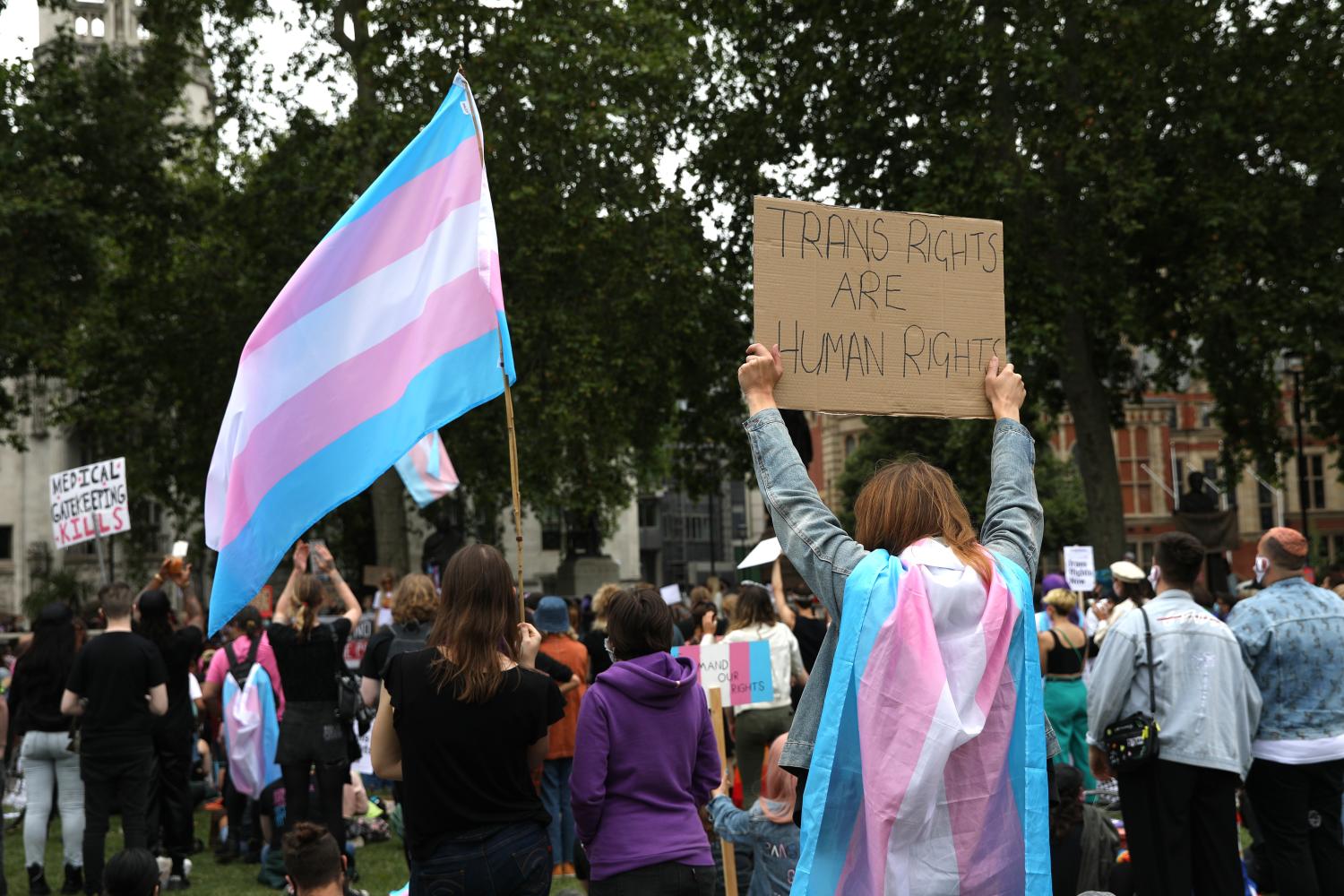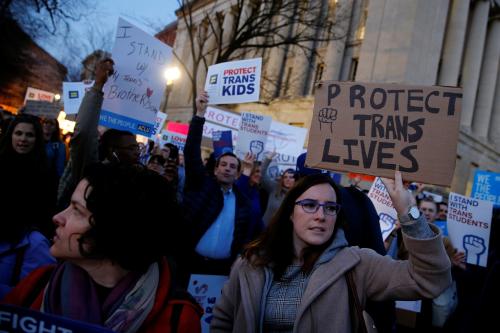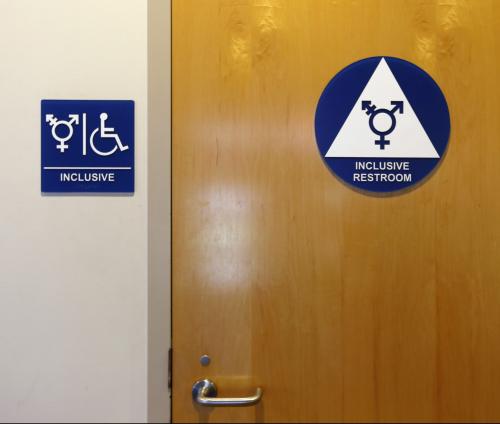A coalition of 20 states recently filed a lawsuit in federal court alleging that the Biden administration had overstepped in extending anti-discrimination protections on the basis of gender identity. The federal agencies targeted by the litigation include the Department of Education and the Equal Employment Opportunity Commission. The lawsuit argues, for example, that the federal government cannot require schools to allow students to join athletic teams and use bathrooms based on their gender identity rather than their sex assigned at birth.
As with so much else happening in education today, the issue of transgender student rights is deeply partisan. Each of the 20 states involved—shaded orange in the map below—has a Republican attorney general spearheading the effort. Several Republican-leaning states—Alabama, Arkansas, Florida, Idaho, Mississippi, Montana, Tennessee, South Dakota and West Virginia—have enacted legislation or executive orders restricting transgender students’ participation in sports. Other legislative efforts have targeted bathroom and locker room access or restrictions on transgender medical care. Collectively, this legislative activity has made for the most active year to date for anti-transgender bills at the state level. Many states’ athletic associations also have issued guidance aimed to restrict transgender students’ access to team sports.
The specific legal issues involved are complicated and beyond the scope of this post. For those interested in more detail on these issues, Suzanne Eckes and Maria Lewis wrote an excellent primer on this blog last October.
Rather, we intend this post as a reminder—grounded in data—that when culture wars descend upon schools, vulnerable children are often caught in the crossfire. That is certainly the case with transgender students’ rights. The data available, limited as they are, reveal clear vulnerabilities among many students who identify as transgender.
Data on transgender students from the YRBS
We explored data from the CDC’s Youth Risk Behavior Survey (YRBS). The CDC, in partnership with states and school districts, has administered the YRBS and related surveys since the early 1990s to monitor the health and well-being of U.S. high school students in most states. (Minnesota, Oregon, and Washington did not participate in 2019.) It contains a set of standard questions, asked of all students in schools randomly selected to participate. It also contains a few optional questions that states (and districts) can decide whether to include. One of these optional questions asks students whether they identify as transgender. (“Some people describe themselves as transgender when their sex at birth does not match the way they think or feel about their gender. Are you transgender?”) Since this item appeared on the state YRBS but not the national YRBS, responses to this item are representative of the participating states but not necessarily the country as a whole.
In 2019, 15 states opted to include the transgender question in their YRBS (with Massachusetts including the question but not making its data publicly available). In doing so, these states not only provided a glimpse of what percentage of their high school students identify as transgender (roughly 2% by our calculations, which is similar to CDC estimates from the 2017 YRBS), but they also enabled researchers to examine these students’ experiences and well-being.
Notably, the states that included this question—shaded in blue in Figure 1 above—are completely distinct from the 20 states that filed the lawsuit against the Biden administration. As a result, we have the least data on transgender students’ experiences in the states that are most hostile to them legislatively. For transgender students, even data collection seems partisan.
While there is, of course, a great deal of variation within any subgroup of students, the YRBS data from states that asked about transgender identity paint a concerning picture. Figure 2 compares responses from transgender students (those who responded, “Yes, I am transgender,” to the item above) and cisgender students (those who responded, “No, I am not transgender”). Differences between transgender and cisgender students’ responses do not necessarily mean that identifying as transgender increases children’s victimization or mental health risk, but the differences are striking and provide insight into the difficulties that many transgender students face.
Transgender students are more than twice as likely as cisgender students in these states to report having been bullied at school (43% vs. 17%) and bullied online (34% vs. 14%) in the last 12 months. Over one-third did not go to school at least once in the last 30 days because they felt unsafe, and, jarringly, nearly as many (28%) reported being forced to have sex in the last 12 months. A majority (61%) of transgender students reported having felt sad or hopeless for two weeks, and disturbingly large percentages had considered (45%) or attempted (29%) suicide at least once in the last year. (The 29% figure is obtained by adding the two light-blue bars at the right end of Figure 2: 14% for transgender students attempting suicide once in the last 12 months, and 15% for multiple attempts in the last 12 months). Across the board, these percentages are significantly higher than the corresponding percentages for cisgender students. Self-reported drug use by transgender-identifying students is also strikingly high, especially for harder drugs such as heroin and methamphetamines (as seen in the 2017 YRBS data).
Transgender students’ participation in team sports has become an especially relevant issue, and the YRBS contains an item, administered to students from select states, that asks “on how many sports teams did you play” during the past 12 months. In the states where we can disaggregate responses by gender identity and sports team participation status—Colorado, Florida, Hawaii, Nevada, and Pennsylvania —we find that 42% of transgender students played at least one sport, compared to 52% of cisgender students. The survey does not ask whether these students played on teams aligned with their gender identity or sex assigned at birth.
This makes it possible to compare responses for transgender students who played team sports and transgender students who did not. Importantly, this does not allow for a causal interpretation of the effects of sports participation on transgender students’ mental health and well-being. There is too much that we can’t observe to make a causal analysis possible, such as personality differences between transgender children who play and don’t play sports.
Figure 3 shows victimization and mental health outcomes for transgender-identifying students, disaggregated by whether they reported playing on a sports team in the last year. We don’t see substantial differences between these groups. However, some of the samples are quite small and corresponding error bars quite large. For context, YRBS data also show similar outcomes between cisgender students who played sports and cisgender students who did not. (Though cisgender students who played sports were slightly less likely other cisgender students to have felt sad/hopeless and considered suicide.)
While the argument for making team sports accessible does not depend on sports participation having positive outcomes for transgender students, this is a topic worth exploring with richer data. Some research—on all students, not just transgender students—suggests possible (positive) links between youth sports participation and students’ longer-term mental health, psychological and social health, and educational and economic outcomes. Effects along these lines for transgender students are certainly plausible, as are negative effects from being denied opportunities on the basis of gender identity.
This brings us to our two primary takeaways.
The first is about data. Our ability to assess the mental health and needs of transgender students shouldn’t be limited to blue states or any other subset of states or districts. Hopefully, the YRBS item on gender identity will soon move from the optional list to the standard list of survey items. Beyond the YRBS, the U.S. Department of Education’s Office for Civil Rights (OCR) has, during the Biden administration, prioritized resources and protections for transgender youth—and expanded its collection of civil rights data. OCR, as well as local and state leaders, could explore appropriate ways to collect data on transgender students’ experiences.
The second is about politics and people. Schools have long been a battleground for culture war issues, but seldom to the extent they are now. Whether the issue is critical race theory, masks, or transgender students’ rights, politicians—specifically, conservative politicians—are finding opportunities to score political points by running with controversial issues in schools. These actions have real consequences for children. Kids know when adults are talking about them, and they get the message when those adults are saying they’re unwanted. Transgender students, as a group, are especially vulnerable, and the numbers above should give anyone pause. We should be going out of our way to ensure that transgender students feel welcome and embraced, not excluded and ostracized.
The Brookings Institution is committed to quality, independence, and impact.
We are supported by a diverse array of funders. In line with our values and policies, each Brookings publication represents the sole views of its author(s).











